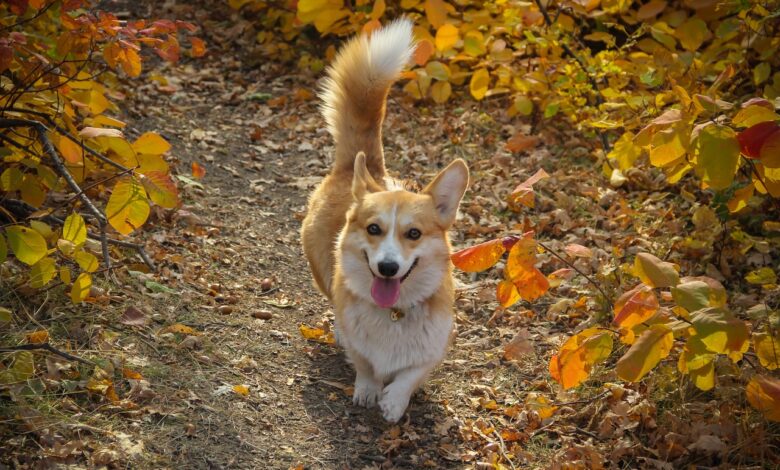Why Do Dogs Chase Their Tails? The Funny Truth Behind It

The image of a dog chasing its tail, spinning in circles with relentless enthusiasm, is a classic and amusing spectacle that has puzzled and entertained dog owners for centuries. While seemingly nonsensical, this behaviour is a multifaceted phenomenon that can be attributed to various factors ranging from physical needs and instinctual behaviours to psychological conditions. Understanding why dogs engage in this whirlwind activity requires a look into their evolutionary past, their development as puppies, and their current mental and physical health. While often harmless and entertaining, it’s a behaviour that can sometimes signal underlying issues that need attention. Delving into why dogs chase their tails satisfies our curiosity and enhances our ability to care for our canine companions, ensuring their well-being and happiness.
Playful Behavior and Boredom
One of the most straightforward explanations for tail-chasing is that it’s a form of playful behaviour widespread in puppies and young dogs. This self-amusement provides an outlet for their high energy levels and curiosity about their bodies. Puppies discovering their tails for the first time may view them as toys or prey, leading to a playful chase. Additionally, in adult dogs, tail chasing can signify boredom. Dogs that do not receive sufficient mental and physical stimulation may resort to chasing their tails to entertain themselves and burn off excess energy. This behaviour underscores the importance of regular exercise and playtime in keeping dogs mentally and physically engaged, preventing boredom and promoting overall health.
Instinctual Predatory Drives
Tail chasing in dogs can also stem from their instinctual predatory drives. In the wild, canines are predators that often stalk as part of their hunting behaviour. While domestic dogs have largely moved away from a lifestyle that requires hunting for survival, many still retain the instinctual urge to chase. The tail, especially when it flicks or moves, can trigger this predatory response, leading to a chase. This behaviour is a remnant of their ancestral past, providing insight into the complex instincts that continue to influence dog behaviour today, even in playful and seemingly inexplicable ways.
Attention-Seeking Behavior
Some dogs may learn that chasing their tail gets a reaction from their human companions, whether it’s laughter, encouragement, or even concern and intervention. This reaction can reinforce the behaviour, turning tail chasing into an attention-seeking activity. Dogs are social animals that crave interaction and engagement with their owners. If they learn that certain behaviours earn them attention, they will likely repeat them. This aspect of tail chasing highlights the importance of understanding how we, knowingly or unknowingly, shape our dogs’ behaviour through our responses to their actions.
Medical Reasons
While tail chasing is often harmless, it can sometimes indicate medical issues. Conditions such as allergies, anal gland problems, or neurological disorders can cause discomfort or irritation around the tail area, leading dogs to chase their tails in an attempt to alleviate the pain. In such cases, tail chasing may be accompanied by biting or licking the tail area. Dog owners must observe their pets closely and consult a veterinarian if tail chasing is excessive or seems driven by discomfort, ensuring that any underlying health issues are addressed promptly.
Psychological Conditions
In some instances, tail chasing can be a sign of psychological conditions such as obsessive-compulsive disorder (OCD) in dogs. Dogs with OCD may engage in repetitive behaviours, including tail chasing, as a manifestation of their condition. These behaviours can become excessive and interfere with the dog’s quality of life, indicating a need for professional intervention. Understanding and addressing these psychological conditions require a compassionate approach and, often, the guidance of a veterinary behaviourist to develop effective management strategies.
Genetic Predisposition
Certain dog breeds exhibit tail-chasing behavior more frequently than others, suggesting a genetic predisposition to this quirky activity. Breeds with high energy levels or those historically bred for herding or hunting may be more inclined to chase their tails due to their natural drive for movement and predation. For example, terriers, known for their tenacity and hunting instincts, might display tail chasing as an expression of their inherent need to pursue and capture. Similarly, herding breeds may interpret their tails as flock members that need to be rounded up. This breed-specific tendency towards tail chasing highlights the importance of understanding and catering to the innate behaviors and needs of different dog breeds, ensuring that their lifestyle is a good match for their genetic predispositions.
Social Learning and Mimicry
Dogs are keen observers of their environment and can learn behaviors by watching other dogs. In multi-dog households, a younger dog may start chasing its tail if it sees an older dog engaging in the behavior, demonstrating social learning and mimicry. This imitation can be a form of social interaction, with younger dogs adopting behaviors from their role models within the pack. It underscores the social nature of dogs and their capacity to learn from one another, extending beyond basic survival skills to include more idiosyncratic behaviors like tail chasing. Recognizing the influence of social dynamics on dog behavior can help owners understand and manage interactions in multi-dog households more effectively.
Exploration and Self-Discovery
For puppies, tail chasing can be a part of their exploration and self-discovery process. As they grow and become more aware of their bodies, puppies may be fascinated by their tails, viewing them as strange and intriguing objects to investigate. This natural curiosity drives them to engage with their tails, leading to playful chasing. This developmental stage is crucial for puppies as they learn about their physical capabilities and limitations, helping them navigate their environment more effectively. Encouraging healthy exploration and providing a variety of toys and activities can help channel puppies’ curiosity in positive ways, supporting their development while reducing the likelihood of developing obsessive behaviors.
Relief from Stress or Anxiety
Just as humans have unique ways of coping with stress or anxiety, dogs too may resort to behaviors like tail chasing as a form of self-soothing. In situations of stress, anxiety, or even frustration, dogs might chase their tails to distract themselves or as a way to release pent-up energy. This behavior can serve as an indicator of the dog’s emotional state, signaling to owners that their pet may be experiencing discomfort or unease. Understanding the emotional triggers that lead to tail chasing can help owners create a more supportive and stress-free environment for their dogs, addressing the root causes of anxiety rather than just the symptoms.
The sight of a dog chasing its tail is more than just a humorous oddity; it’s a behaviour that spans playful engagement, instinctual drives, attention-seeking, and, in some cases, health concerns. While often a normal and harmless part of dog behaviour, understanding the various reasons behind tail chasing can help owners ensure their canine companions are healthy, happy, and well-adjusted. Recognizing when this behaviour crosses the line from amusement to a potential sign of distress is crucial in providing the best care for our furry friends. Through observation, engagement, and care, we can better understand and respond to the many facets of dog behaviour, tail chasing included, enriching the lives of both dogs and their human families.






